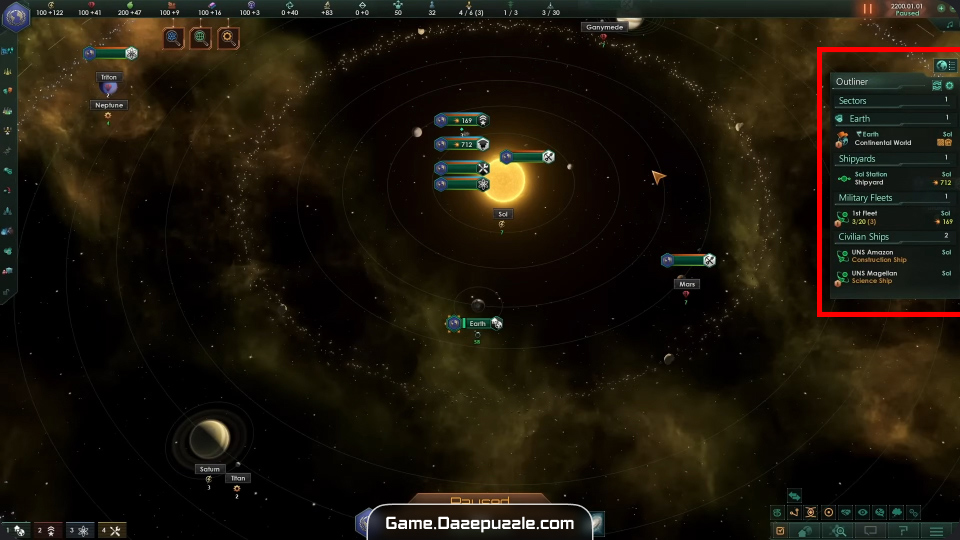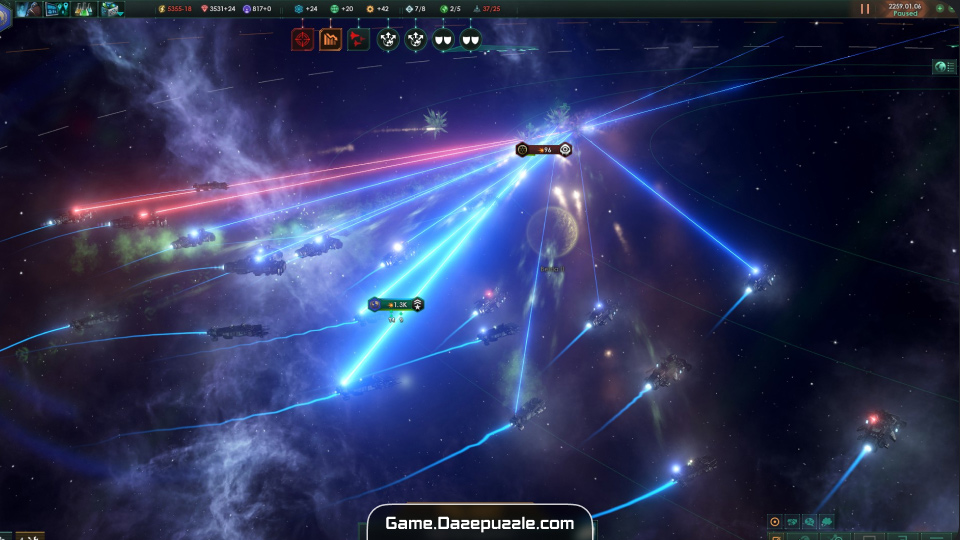Welcome to the ultimate Stellaris Beginner’s Guide! If you’re stepping into Stellaris for the first time, this epic space strategy game by Paradox Interactive might feel like navigating a massive, unknown galaxy. But don’t worry. We’re here to make it simple and fun, so you can lead your empire to glory. This guide is tailored for the base game (patch 3.8 as of 2023) without any DLCs, perfect for new players. Let’s dive into the stars and start your journey!
Starting Your Empire: The First Steps
When you launch Stellaris, you’ll enter the Empire Designer to create your species and government. For your first game, we suggest picking a premade civilization like the United Nations of Earth. It’s well-balanced and beginner-friendly, letting you focus on learning the game instead of tweaking settings.
Tweaking Your Empire
If you want to customize, here’s what you can change in the Empire Designer:
- Species Traits: These give small bonuses or penalties, like faster population growth or better research. For now, stick with the defaults to keep things easy.
- Homeworld Class: Pick from dry (like deserts), wet (like oceans), or frozen (like arctic) worlds. Your species thrives best on their homeworld type.
- Ethics and Government: These shape your empire’s bonuses and playstyle. For example, egalitarian ethics make your people happier, while militaristic ones strengthen your fleets. The default settings are great for beginners.
- Origin: This sets your starting story. The default “Prosperous Unification” gives early bonuses, making it ideal for new players.
Don’t overthink these choices, default settings work perfectly for your first game!
Understanding the Game Screen: Your Galactic Control Panel
Once you start, the screen might look packed with menus and numbers. Let’s break it down so it feels less overwhelming.
Resources: The Top Bar
Your empire depends on resources, displayed at the top of the screen. Here’s a quick rundown:
| Resource | What It Does | How to Get It |
|---|---|---|
| Energy Credits | Cash for upkeep (fleets, buildings) | Planets, space stations |
| Minerals | Build structures, make advanced resources | Planets, mining stations |
| Food | Feed your population | Planets, starbases |
| Consumer Goods | Support jobs (like researchers) | Planets (needs minerals) |
| Alloys | Build and maintain ships | Planets (needs minerals) |
| Influence | Expand borders, interact with empires | Rivalries, power projection |
| Unity | Unlock traditions, hire leaders | Planets |
| Research | Develop new technologies | Planets, research stations |
Rare resources, like gases or crystals, are used for advanced buildings and ships later in the game. Empire Size isn’t a resource but tracks how big your empire is. A larger empire increases the cost of tech and traditions, so try to keep this number low early on.
The Outliner: Your Empire Overview
On the right side, the Outliner shows your planets, fleets, and ships. Click the settings cog to choose what appears, like hiding unused items. This tool helps you keep track of everything in your empire.

Controlling Time
Stellaris runs in real-time, but you can pause (press the spacebar) or adjust the speed. The game starts paused, so nothing happens until you unpause. You can queue up actions while paused and then hit play to watch them happen.
Your First Moves: Exploring the Galaxy
Your starting system includes a starbase, a small fleet, a science ship, and a construction ship. Here’s how to kick things off:
Surveying with Science Ships
Select your science ship and right-click a nearby system to survey it. Surveying reveals resources and habitable planets, which are crucial for expanding your empire. Focus on systems with green habitability icons, as these planets are easier for your species to colonize. You can automate surveying, but manually picking systems helps you learn the ropes.
Building with Construction Ships
Use your construction ship to build mining stations in surveyed systems to gather resources like minerals or energy. You can also build outposts to claim new systems, expanding your borders. Outposts cost influence, so choose systems with valuable resources or planets.
Researching Technologies
Click the Research tab to choose technologies. Unlike other strategy games, Stellaris offers three random options at a time (physics, society, or engineering). Each tech costs research points, which your researchers produce monthly. Early on, pick techs that boost resources or unlock new buildings. The tech tree is hidden, which adds excitement as you discover new options.
You might also like this: Top 5 Hidden Gem Indie Games in 2025 You should play!
Managing Your Capital: Earth
Your homeworld (like Earth) is the heart of your economy. Click it to open the Planetary View and start managing.
Districts and Buildings
Planets have districts for housing and basic jobs (like farming) and buildings for specialized jobs (like research labs). Districts are limited by the planet’s size, but you can build up to 12 buildings. Start by adding districts for resources (e.g., agriculture for food) and buildings for advanced production (e.g., alloy foundries for ships).
Pops: Your Workforce
Pops represent your population and work jobs to produce resources. They come in three classes:
- Workers: Produce basics like food or minerals.
- Specialists: Create advanced resources like alloys or research.
- Rulers: Generate unity and help keep planets stable.
In the Population tab, you can see which jobs your pops are working. For now, avoid changing job priorities. Let pops fill roles automatically to keep things simple.
Keeping Planets Stable
Stability affects your planet’s output. If it’s above 50, you get bonuses; below 50, you face penalties, and very low stability (25-40) can lead to revolts. Keep pops happy with amenities (from buildings like entertainment centers) and enough housing. If crime is below 30, you don’t need enforcers yet.
Growing Your Empire
To thrive, you need to expand your empire carefully. Here’s how:
Colonizing New Worlds
Surveyed systems may reveal habitable planets (look for green icons). Build a colony ship at your starbase’s shipyard and send it to the planet. Colonizing costs resources and takes time, but new colonies boost your economy. Focus on planets with high habitability (70% or more) to avoid penalties.
Managing Starbases
Starbases are upgraded outposts, starting with one in your capital system. Add modules like shipyards or trade hubs to support your fleets or economy. Stay under your starbase capacity to avoid extra upkeep costs. Research techs or claim more systems to increase this limit.
Building Your Fleet
Your naval capacity limits how many ships you can have. Going over this cap increases ship upkeep, which can strain your economy. Build anchorages in starbases or research techs to raise your capacity. A strong fleet keeps enemies at bay, so maintain one close to your limit.

Meeting Aliens: Diplomacy and First Contact
You’ll soon encounter other empires. Assign an envoy to complete first contact, which takes a little time. After that, you can:
- Make pacts, like non-aggression or research agreements.
- Trade resources or favors.
- Declare war, but you’ll need claims (made with influence).
As a beginner, focus on peaceful diplomacy to avoid early conflicts. Use the Contacts tab to manage your relationships.
Unlocking Traditions and Perks
Unity is a resource that unlocks traditions, which give empire-wide bonuses. Start with the Discovery tree to improve research and exploration speed. Completing a tradition tree earns an Ascension Perk, like better leaders or powerful buffs. Choose perks that fit your goals, like boosting your economy or military.
You can also activate edicts in the Government tab. These cost unity but provide temporary bonuses, like faster construction. Use your free edict fund to avoid draining your unity stockpile.
Scaling Up: Late-Game Strategies
As your empire grows, here are some tips to stay on top:
Controlling Empire Size
More colonies and systems increase your empire size, which raises the cost of technologies and traditions. Build administrative buildings, like bureaucratic centers, to reduce these penalties and keep your empire efficient.
Managing Leaders
Leaders (like admirals, scientists, or governors) have a soft cap. Going over this limit increases upkeep and slows their experience gain. Hire leaders with traits that match your needs, such as research boosts or fleet strength.
Designing Fleets
For now, keep auto-generate ship designs enabled to avoid complexity. Later, use the Ship Designer to customize ships for specific enemies, like adding armor-piercing weapons against shielded foes. Check advanced guides for detailed fleet strategies.
Using the Market
The Market lets you trade resources using energy credits. Set monthly buy or sell orders to balance your economy, but be aware that heavy trading affects prices. Early on, sell extra food or minerals to fund new buildings or ships.
Mistakes to Avoid as a Beginner
Here are some common pitfalls and how to dodge them:
- Expanding Too Fast: Claiming too many systems early uses up influence and increases empire size. Focus on systems with planets or valuable resources.
- Ignoring Stability: Low stability hurts your economy. Build amenity-producing buildings if your pops are unhappy.
- Weak Fleets: A small navy makes you a target. Keep a fleet near your naval capacity to deter attacks.
- Over-Managing Jobs: Don’t tweak job priorities until you’re comfortable with the system. Let pops sort themselves out early on.
Your Galactic Adventure Awaits
This Stellaris Beginner’s Guide equips you to conquer the cosmos. Start with the United Nations of Earth, send out science ships, manage your homeworld, and expand thoughtfully. Pause often to plan your moves, and don’t be afraid to experiment. Making mistakes is part of the fun! As you grow, explore traditions, diplomacy, and epic fleet battles to shape your empire’s legacy.
Ready to rule the galaxy? Fire up Stellaris, follow this guide, and share your awesome stories with other players. Have questions? Let us know below, and let’s keep exploring the stars together!






